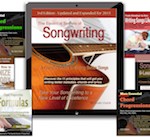 In the process of songwriting, many songwriters actually start with the chorus. That’s because the chorus tends to use shorter, stronger (and simpler) chord progressions, hooky melodies that use repeating ideas, and emotional lyrics. By comparison, the verse can be a bit more of a challenge. You need lyrics that describe people and/or situations, and then create a melody with accompanying chords that support those lyrics. A verse melody, and the chords supporting it, tend to have a more complex structure than what we find in the chorus.
In the process of songwriting, many songwriters actually start with the chorus. That’s because the chorus tends to use shorter, stronger (and simpler) chord progressions, hooky melodies that use repeating ideas, and emotional lyrics. By comparison, the verse can be a bit more of a challenge. You need lyrics that describe people and/or situations, and then create a melody with accompanying chords that support those lyrics. A verse melody, and the chords supporting it, tend to have a more complex structure than what we find in the chorus.
But for most, the biggest problem isn’t coming up with a good verse — it’s deciding what to do about Verse 2.
Since a chorus is a commentary on the verse, it makes coming up with verse 2 a bit of a challenge. If your song is the telling of a story, it’s somewhat easy: keep telling the story. But songs that tell stories are somewhat rare. In many songs, the verse describes a state of mind. So then what do you do?
 “The Essential Secrets of Songwriting” shows you how to write great songs. It’s just one of a suite of 6 songwriting e-books written by Gary Ewer. Let these six e-books show you every aspect of how to write great songs! Read more..
“The Essential Secrets of Songwriting” shows you how to write great songs. It’s just one of a suite of 6 songwriting e-books written by Gary Ewer. Let these six e-books show you every aspect of how to write great songs! Read more..
Here are some tips to follow when trying to create a Verse 2 for your song. Not all these ideas will work for your song, but they’ll at least hopefully stimulate your imagination and help you create something that works.
- Build instrumentation. You know that a chorus will use a relatively full instrumentation when compared to Verse 1. Most of the time, Verse 2 will use an identical, or almost identical instrumentation to Verse 1. But a long, gradual build in instrumentation can help to create energy and momentum. To hear this kind of thing in action, listen to Phillip Phillips’ “Home” and Ellie Goulding’s “Lights”.
- Build vocals. Verse 2 is a great place to introduce some vocal harmonies. The chorus is a great place to use harmonies, but Verse 2 can use vocal harmonies as a way of increasing the emotional impact of your song’s message.
- Reword Verse 1. It’s surprising how many songs do a simple rewording of the ideas and situations in Verse 1 to create a Verse 2. Or use Verse 2 to restate the philosophy or opinion you stated in Verse 1.
- Build from using implied chords to fuller ones. An implied chord means giving a very sparse accompaniment that doesn’t include the full chord. So you could sing Verse 1 with just a bass and very light, transparent chords on guitar, and switch to something fuller in Verse 2.
In any case, it’s quite acceptable to have Verse 1 sound pretty much identical to Verse 2 (with the exception of lyrics, of course), as long as you follow the important songwriting principle that song energy should generally increase as a song proceeds, resulting in higher energy at the end than at the beginning. So if you don’t do that with your verse structure, you’ll need to do it in other ways, but building energy through the repeat of your choruses and/or in the bridge.
__________
Written by Gary Ewer
If you want to learn more about song structure, and how hit songwriters from the past 60 years have created their great hits, get “The Essential Secrets of Songwriting” 6-eBook Bundle. Available for immediate download.










Hi, great post.
How would you recommend going on with the second verse if the song doesn’t have any lyrics/vocals? Do you have any tips in general how to write a song without vocals – having only the instruments to hold the interest of the listener?
Theres so much energy in vocals that i’m having trouble coming up with ideas for instruments to hold the same level of energy or “catchiness” as vocals do.
Would love to see a blog post on this perhaps.
Thanks,
Ermin
Hi Ermin:
For instrumental music, the same principles apply, which is to find ways to build energy in the second verse. Some ways to do that are:
1) Thicken instrumental textures by adding octave voicings in instruments such as keyboard and possibly guitars.
2) Introduce a busier rhythmic component in the backing instruments.
3) Add instruments in an octave that didn’t exist in verse 1 (for example, add high strings in verse 2).
4) Transpose to a new key. Almost always this would need to be a higher key.
Those are just a few ideas that come to mind. You might also want to read a couple of posts I did in the past on instrumental music, specifically “Writing Instrumental Music: It’s the Motif that Gives it Life“, and “Using Implied Chords to Lighten Instrumental Textures“.
Hope that helps,
-Gary